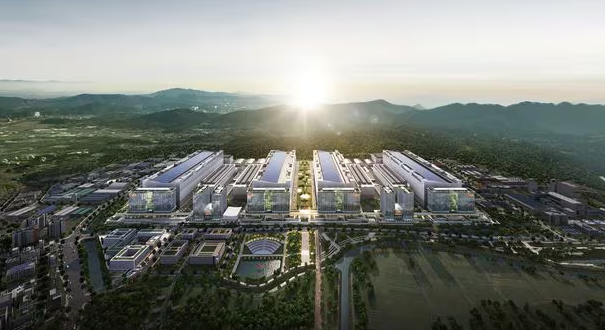
Aerial view of SK Hynix's semiconductor cluster in Wonsam-myeon, Yongin-si, South Korea.
Warnings have been issued that the world’s largest semiconductor cluster, set to be built in Pyeongtaek, Hwaseong, Yongin, and Icheon, in Gyeonggi Province, South Korea, with an investment of 622 trillion won ($452.4 billion), could face severe electricity shortages even after the factories are operational. In just 12 years, the cluster will need to import large amounts of electricity from the East Coast and Honam, but the proposed transmission lines have yet to be finalized.
The demand for electricity in the metropolitan area, densely populated with semiconductor factories and other advanced facilities, is growing rapidly. By 2038, the electricity demand for semiconductors and data centers in this area alone will be equivalent to the output of 15 new nuclear power plants. The current state of the transmission and distribution grid could lead to a power shortage. While the Korean government insists there will be no problem if the grid is completed as planned, critics argue this is an overly optimistic view given the ongoing delays in grid construction.
A former senior energy official said, “Given the government’s current complacency, it is difficult to finish the transmission and distribution network construction on time. A new timetable and expedited construction are the only ways to prevent a ‘catastrophe.’”
In the southern Gyeonggi cluster, where 16 new semiconductor factories are scheduled to be built by 2047, five are expected to be completed in 2027, according to the government and industry sources as of Jun. 4. The electricity demand for these factories alone will be equivalent to that of three to four nuclear power plants. Considering that the East Coast-Shingapyung line, already five years overdue, is not expected to be operational until 2026, a power crisis in the metropolitan area is imminent.
Ten semiconductor factories in the Yongin area, the cluster’s core, are projected to increase the metropolitan area’s electricity demand by 25% by 2050. With the expected surge in electricity demand due to new semiconductor factories, data centers, the spread of electric vehicles, and the electrification of household appliances, state-of-the-art factories, and facilities may struggle to operate without sufficient electricity.
Professor Emeritus Sonn Yang-hoon of the University of Incheon said, “For reasons such as securing human resources, high-tech industries are naturally located in the metropolitan area. The issue can be resolved by recognizing the construction of transmission and distribution grids as an essential industry for the country’s future, just like semiconductors.”

-advertisement-
Editor:Vicky
▼▼▼
Apollo to pay $11 bln for 49% of Intel Ireland factory joint venture
ASML, Belgium's Imec open laboratory to test newest chip-making tool
Samsung phones lead in market share in 38 countries; iPhones top in 16
The founder of Future Electronics was arrested on multiple counts of sexual exploitation
Elon Musk pledges to spend around $9 billion to acquire chips for xAI
+86 191 9627 2716
+86 181 7379 0595
8:30 a.m. to 5:30 p.m., Monday to Friday
